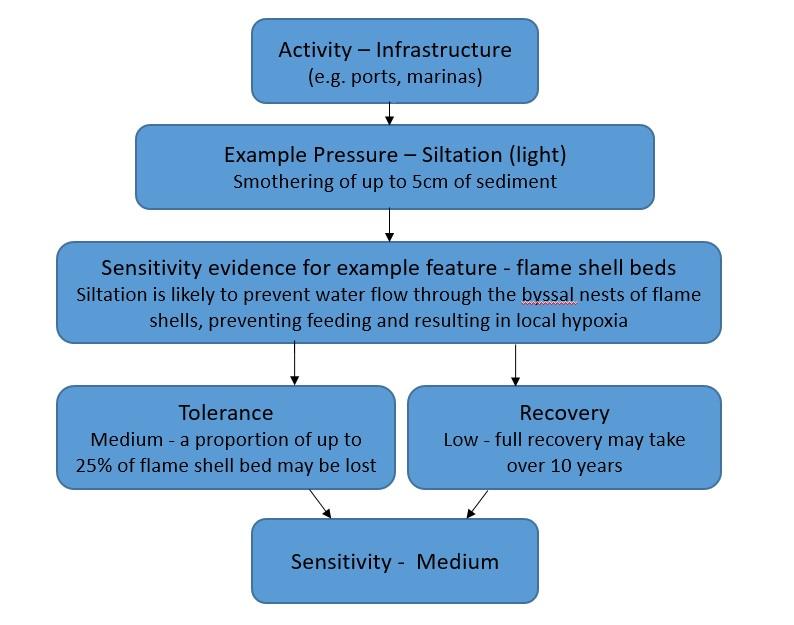Feature Activity Sensitivity Tool (FeAST)
The Feature Activity Sensitivity Tool (FeAST) is a web-based application which allows users to investigate the sensitivity of marine features.
The Feature Activity Sensitivity Tool (FeAST) is a web-based application which allows users to investigate the sensitivity of marine features (habitats, species, geology and landforms) in Scotland's seas, to pressures arising from human activities. FeAST has been devised as a tool to be used in a variety of ways by anyone with an interest in potential impacts on marine features, for example:
- Conservation advisers and consultants,
- Developers, Planners and other regulators,
- People who work in marine industries (e.g. offshore development and marine renewables, fisheries, aquaculture, shipping, seaweed harvesting, marine tourism and recreation).
Scotland's Marine Assessment 2020 used FeAST to underpin the pressure assessments required under the Marine (Scotland) Act 2010. FeAST is also being used to inform discussions on management requirements for Marine Protected Areas and Priority Marine Features.
FeAST Updates
The tool has undergone a review, and a new interface has been built to increase functionality and improve user experience. Please view the updated tool via the website link below. Please note the page is currently in Beta mode whilst the final stages of user testing / bug-fixing are carried out. If you have any comments after using the tool please complete this user feedback form.
FeAST
The long-term aim is that information on the sensitivity of all Scottish marine features of conservation importance will be held in FeAST. The revised list of human-induced pressures used in the Scotland’s Marine Assessment (2020) has been incorporated into the updated tool (adapted from an inventory prepared and agreed by OSPAR Joint Assessment Monitoring Programme 2014-2021: see Table II therein).
Further sensitivity assessments will be added to FeAST over time, in addition to those already present in FeAST, and include:
- Additional Nature Conservation Marine Protected Area (MPA) habitats in inshore waters.
- Additional Nature Conservation Marine Protected Area (MPA) habitats in offshore waters.
- The full list of Priority Marine Features (PMF), as adopted by Scottish Ministers in 2014 to help deliver marine conservation.
- Marine habitats present in Special Areas of Conservation (SACs) in Scotland and are considered internationally important under the EC Habitats Directive (listed in Annex I of the Directive).
- Mobile species including cetaceans, marine birds and fish species of conservation importance.
This work is being developed through the FeAST Working Group (NatureScot, Joint Nature Conservation Committee, the Scottish Government and Scottish Environment Protection Agency).
Relevant publications
A review was carried out to determine how best to categorise marine mammal sensitivity using methods consistent with FeAST. An initial suite of five marine mammal assessments was drafted using an individual based approach (as opposed to a population one).
NatureScot Research Report 11735 Developing FeAST for mobile marine species.
Further work was commissioned to complete 36 sensitivity assessments for marine birds:
NatureScot Research Report 1273 - Development of Marine Bird Sensitivity Assessments for FeAST
Sensitivity Assessment Methods
Sensitivity assessments use the best available evidence to assess the likely response of a marine feature to anthropogenic pressures. This is done by considering a feature’s tolerance (ability to absorb or resist change or disturbance) to a pressure and its likely ability to recover, should the pressure be stopped. The sensitivity assessment process uses pressure benchmarks where possible to provide a measure of the pressure to assess against, but it does not take into account the intensity, frequency or cumulative impacts from activities taking place at specific locations. One example of summarised information for flame shell bed sensitivity is given in the graphic below.

The flow diagram for the flame shell bed sensitivity assessment process -
- Activity - Infrastructure (e.g. ports, marinas)
- Arrow points to Example pressure - siltation (light) - Smothering of up to 5cm of sediment
- Arrow points to Sensitivity evidence for example feature - flame shell beds. Siltation is likely to prevent water flow through the byssal nests of flame shells, preventing feeding and resulting in local hypoxia.
- Separate arrows point to
- Tolerance - medium - a proportion of up to 25% of flame shell bed may be lost
- Recovery - Low - full recovery may take over 10 years
- Both arrows point to - Sensitivity - Medium
The flow diagram displays an example of summarised information obtainable from FeAST when interrogated from the starting point of a marine activity. A development involving coastal infrastructure which may cause light siltation pressure (smothering of up to 5 cm of silt), could restrict water flow through marine habitats. Local hypoxia could occur in e.g. flame shells beds, where a score of Medium tolerance and Low recovery are given for this feature resulting in a Medium sensitivity score.





